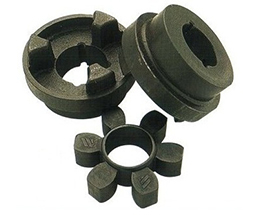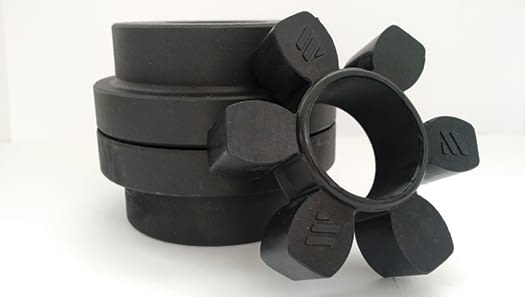Product Description
SC Transmission FCL Flange Flexible Coupling
Product Description
CHARACTERISTICS
FCL Coupling Flange Coupling has simple construction that makes it:
Easy to assemble and disassemble, easy parts replacement.
It is able to transmits power smoothly even under vibration and shock due to its ability to absorb shock and load vibration.
It is also able to transmit power under parallel and angular misalignment, and end-floating.
Smooth running.
Permit reverse revolution.
Full range available from Size 90 to 630
Applications
SC Transmission flange flexible coupling has a wide range of applications: pump, blower, compressor, conveyor, crane & hoist, cement mixer, tractor, rolling mill, metal processing machine, spinning and weaving machinery etc.
Product Parameters
| SIZE | D | D1 | d1 | L | C | n-M | kg | |||
| r/min | ||||||||||
| N.m | ||||||||||
| FCL90 | 4 | 4000 | 90 | 35.5 | 11 | 28 | 3 | 4-M8 | 1.7 | |
| FCL100 | 10 | 4000 | 100 | 40 | 11 | 35.5 | 3 | 4-M10 | 2.3 | |
| FCL112 | 16 | 4000 | 112 | 45 | 13 | 40 | 3 | 4-M10 | 2.8 | |
| FCL125 | 25 | 4000 | 125 | 65 | 50 | 13 | 45 | 3 | 4-M12 | 4 |
| FCL140 | 50 | 4000 | 140 | 71 | 63 | 13 | 50 | 3 | 6-M12 | 5.4 |
| FCL160 | 110 | 4000 | 160 | 80 | 15 | 56 | 3 | 8-M12 | 8 | |
| FCL180 | 157 | 3500 | 180 | 90 | 15 | 63 | 3 | 8-M12 | 10.5 | |
| FCL200 | 245 | 3200 | 200 | 100 | 21 | 71 | 4 | 8-M20 | 16.2 | |
| FCL224 | 392 | 2850 | 224 | 112 | 21 | 80 | 4 | 8-M20 | 21.3 | |
| FCL250 | 618 | 2550 | 250 | 125 | 25 | 90 | 4 | 8-M24 | 31.6 | |
| FCL280 | 980 | 2300 | 280 | 140 | 34 | 100 | 4 | 8-M24 | 44 | |
| FCL315 | 1568 | 2050 | 315 | 160 | 41 | 112 | 4 | 10-M24 | 57.7 | |
| FCL355 | 2450 | 1800 | 355 | 180 | 60 | 125 | 5 | 8-M30 | 89.5 | |
| FCL400 | 3920 | 1600 | 400 | 200 | 60 | 125 | 5 | 10-M30 | 113 | |
| FCL450 | 6174 | 1400 | 450 | 224 | 65 | 140 | 5 | 12-M30 | 145 | |
| FCL560 | 9800 | 1150 | 560 | 250 | 85 | 160 | 5 | 14-M30 | 229 | |
| FCL630 | 15680 | 1000 | 630 | 280 | 95 | 180 | 5 | 18-M30 | 296 | |
Company Profile
FAQ
Shipping
/* January 22, 2571 19:08:37 */!function(){function s(e,r){var a,o={};try{e&&e.split(“,”).forEach(function(e,t){e&&(a=e.match(/(.*?):(.*)$/))&&1
| Standard Or Nonstandard: | Standard |
|---|---|
| Shaft Hole: | 11-95 |
| Structure: | Flexible |
| Material: | Cast Iron |
| Type: | FCL Coupling |
| Transport Package: | Plywood Case |
| Samples: |
US$ 10/Piece
1 Piece(Min.Order) | |
|---|
| Customization: |
Available
| Customized Request |
|---|


Can HRC Couplings Accommodate High Torque and High-Speed Applications?
HRC (Highly Resilient Coupling) couplings are designed to handle a wide range of torque and speed requirements, making them suitable for various industrial applications, including those involving high torque and high-speed conditions. Their ability to accommodate high torque and high-speed applications depends on several factors:
- Coupling Size and Type: HRC couplings come in various sizes and types, each with its torque and speed ratings. Larger couplings with robust designs can handle higher torque and speed than smaller ones.
- Material Composition: HRC couplings consist of a metal hub and a flexible elastomeric element. The material composition of the elastomer plays a significant role in determining the coupling’s torque and speed capabilities.
- Elastomer Properties: The elastomeric element in HRC couplings provides flexibility and damping. It should be selected based on its resilience, durability, and ability to withstand the intended torque and speed requirements.
- Application Requirements: The coupling’s torque and speed ratings must match or exceed the demands of the application. Factors such as the driven and driving equipment’s power, load characteristics, and operational conditions should be considered.
- Proper Installation: Correct installation, including accurate alignment and proper torqueing of the coupling, ensures optimal performance and minimizes the risk of premature failure in high torque and speed applications.
It’s important to consult the manufacturer’s specifications and guidelines to select the appropriate HRC coupling for a specific high torque and high-speed application. Using an undersized or unsuitable coupling can lead to premature wear, reduced efficiency, and potential safety hazards.
In summary, HRC couplings are well-suited for high torque and high-speed applications when properly selected, installed, and maintained. They offer the benefits of damping vibrations, shock absorption, and misalignment compensation while reliably transmitting power in demanding industrial settings.

Can HRC Couplings Be Used in Both Horizontal and Vertical Shaft Arrangements?
Yes, HRC (Highly Resilient Coupling) couplings can be used in both horizontal and vertical shaft arrangements, making them versatile options for various applications.
Horizontal Shaft Arrangements: In horizontal shaft arrangements, the shafts are positioned parallel to the ground, and the rotational axis is horizontal. HRC couplings are commonly used in this configuration to transmit torque between two shafts with a certain level of misalignment. They are particularly effective in absorbing shock loads, dampening vibrations, and compensating for slight misalignments, which are often encountered in rotating machinery.
Vertical Shaft Arrangements: In vertical shaft arrangements, the shafts are positioned vertically, and the rotational axis is perpendicular to the ground. This configuration is commonly found in applications such as vertical pumps, vertical motors, and gearboxes. When using HRC couplings in vertical shaft arrangements, additional consideration is required to ensure that the coupling can support the weight of the connected equipment and accommodate any potential misalignment due to gravitational forces.
When selecting an HRC coupling for a vertical shaft arrangement, it is essential to choose a coupling with adequate torque capacity and stiffness to handle the weight of the equipment and any dynamic forces resulting from the vertical orientation.
In summary, HRC couplings are suitable for both horizontal and vertical shaft arrangements, providing reliable power transmission and compensating for misalignment and vibration in various mechanical systems.

Limitations and Disadvantages of Using HRC Couplings
HRC couplings offer numerous advantages for power transmission in various mechanical systems, but they also have some limitations and disadvantages to consider:
- Misalignment Limitation: While HRC couplings can handle a degree of misalignment, they are not as flexible as some other coupling types, such as flexible or elastomeric couplings. Excessive misalignment beyond their specified limits can lead to premature wear and failure.
- High Shock Loads: While HRC couplings can handle moderate shock loads, they may not be suitable for applications with very high shock loads. In such cases, specialized couplings like gear or disc couplings may be more appropriate.
- Temperature Limitations: HRC couplings have temperature limitations based on the material used in their construction. In high-temperature environments, other coupling types, such as metal disc couplings, may be more suitable.
- Noise and Vibration: HRC couplings are not as effective in dampening noise and vibration as some other coupling designs, like flexible couplings with elastomeric elements. In applications where noise reduction is critical, additional measures may be required.
- Regular Maintenance: While HRC couplings are generally low-maintenance, they still require periodic inspection and lubrication to ensure optimal performance and prevent unexpected failures.
- Component Wear: The flexible elements of HRC couplings, such as the rubber inserts, may experience wear over time, especially in demanding applications. Regular inspection and replacement of these elements may be necessary.
- Size and Weight: HRC couplings may be larger and heavier than some other coupling types, which can be a consideration in applications where space and weight are limited.
- Cost: HRC couplings can be more cost-effective than some high-performance couplings, but they may not offer the same level of performance and precision in certain applications.
Despite these limitations, HRC couplings remain a popular choice in many industrial applications due to their reliability, simplicity, and cost-effectiveness. Engineers and designers should carefully assess their specific application requirements and consider these factors when selecting the most suitable coupling type for their system.


editor by CX 2024-04-12
by
Leave a Reply